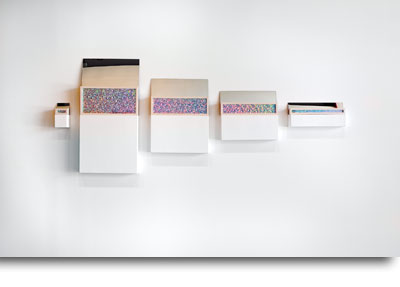Aug 2008

PORTLAND
Jacqueline Ehlis at New American Art
Union
That Jacqueline Ehlis is a Dave Hickey protégée is not a Rosetta
Stone to her work, but it’s a good start. Sure, Ehlis’ work exudes the brand of
exuberant abstraction that her former professor at UNLV tenaciously champions
(Hickey recently curated Ehlis into his “Las Vegas Diaspora” traveling
exhibition), but in “Serenade,” her first solo show at New American Art Union,
Ehlis proved that her shiny, glinting creations are more than just eye candy.
With its winning wit and fastidious execution, the show was an exercise in
tarted-up deconstruction, equally unafraid of beauty or provocation.
Many
of the works in the show riffed on the idea of blurring distinctions between
media. In the triptych, Flush, Poise, and Immerse, scrolls of primary-colored
construction paper unfurled into polished aluminum wave shapes, which projected
sculpturally into the room. Beneath these forms hung canvases that were blank
except for a single strip of color on each edge; in turn, the canvases were
mounted on sheets of steel visible only from the side. The use of construction
paper imparted an evolutionary feel, as if a kindergarten drawing class had
quantum-leapt into a master metalworker’s studio. In Cinema of the Blushing
Skin, the artist projected semi-abstract photographs onto three canvases, each
subdivided into three vertical planes of differing finishes. The left side of
each canvas was painted DayGlo colors—fluorescent yellow, fuchsia, and
blue—which cast ghostly chromatic echoes onto the walls behind them,
transgressing the canvases’ borders and, in a favorite Ehlis motif, subtly
invading the viewer’s personal space.
Essentially minimalist and
deconstructive, Serenade avoided over-earnestness via the works’ Pop colors and
juxtaposition of lowbrow materials and “finish fetish” finesse. This confluence
came through most clearly in Delightful Exaltations, in which sheets of sparkly
vinyl paper—the sort used in baseball cards and novelty stickers—were drolly
presented in wooden frames, vertically sandwiched between blank canvases below
and mirrors above. Cagey stuff indeed: the blank canvases offered no content;
the framed pieces gave only the ephemera of the cheap thrill; and, at the top,
the mirror implicated and invited the viewer to reflect, literally, on whether
“content” is necessary in an era of froth and flash.
